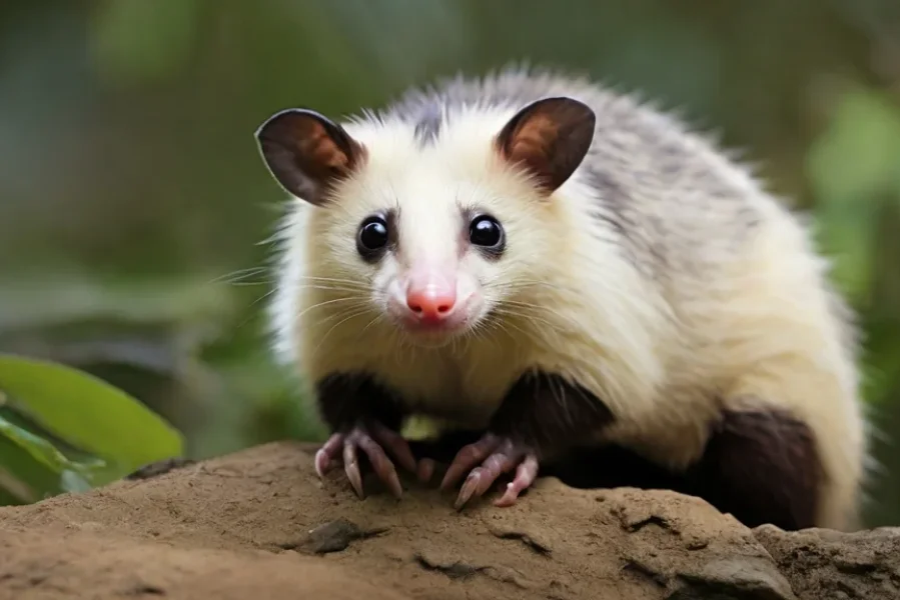Tñacuaches and the Art of Playing Dead: Survival Tactics Explained
The tñacuache—also known as “tlacuache” in some regions—is the Mexican name for the Virginia opossum (Didelphis virginiana), a fascinating marsupial found across the Americas. This unique animal is famous for its incredible adaptability, and its instinctive “playing dead” defense, known as thanatosis, is a key trait that distinguishes it within the mammalian world.
One of the tñacuache’s most notable features is its ancient lineage, as it ranks among the oldest surviving marsupials, tracing back millions of years. Unlike placental mammals, marsupials like the tñacuache birth underdeveloped young, which then continue growing in the mother’s pouch.
Where Tñacuaches Live: Habitat and Range
Tñacuaches thrive across a vast range of environments, from lush tropical forests to urban neighborhoods, and are common in Central and North America, including Mexico, the United States, and parts of Canada. Here are some of the key aspects of their habitat:
- Adaptability: Tñacuaches are versatile and can easily adjust to urban settings, where they are often spotted scavenging around human settlements.
- Natural Habitat: In the wild, they favor areas close to water sources such as rivers and streams, where food is plentiful.
- Climate Tolerance: They can withstand both hot and cold environments, contributing to their widespread distribution.
Tñacuache’s Behavior and Survival Skills
As nocturnal creatures, tñacuaches are most active at night, which helps them evade predators and reduces competition for resources. Typically solitary, they only gather during mating season.
Their strong, prehensile tails allow them to grip branches, aiding in climbing and navigating forested areas. One of their most famous behaviors, “playing dead,” involves collapsing, emitting a foul smell, and lying still to convince predators they are not a threat. This tactic can be surprisingly effective against many predators.
The Tñacuache Diet: A Diverse Menu
Tñacuaches are omnivores, eating both plant and animal matter, which allows them to thrive in diverse habitats. Their diet includes:
- Fruits and Vegetables: They consume a variety of fruits like berries and apples, and vegetables when available.
- Insects and Small Animals: They hunt insects, frogs, birds, and even small rodents.
- Scavenging: Known scavengers, they often feed on carrion.
- Human Food: In urban areas, they are known to raid garbage bins and eat discarded food.
This adaptable diet supports their survival across changing environments, highlighting their resilience as a species.
Tñacuaches: Unsung Heroes of Ecosystem Balance
Often underestimated, tñacuaches play a vital role in maintaining ecological balance. By eating insects, they help control pest populations, which is especially beneficial in agricultural settings. They also contribute to seed dispersal by consuming fruits, and by scavenging, they help clean up carrion, reducing disease spread. Through hunting small rodents, tñacuaches provide a natural form of pest control.
Their ecological contributions include:
- Pest Control: They consume numerous insect pests, like cockroaches and ticks.
- Seed Dispersal: They spread seeds through their diet, supporting plant diversity.
- Decomposition: As scavengers, they help decompose animal remains, keeping environments clean.
Tñacuaches’ Nightly Routine: Life in the Dark
Being nocturnal, tñacuaches have keen night vision and a sharp sense of smell to help them forage in darkness. They roam at night, often covering significant distances in search of food, and revisit places where they previously found sustenance. Typical nighttime activities involve:
- Urban Scavenging: Foraging in garbage bins around urban areas.
- Foraging for Fruits: Searching for fruit and other food in forests.
- Avoiding Predators: Staying hidden from predators like coyotes and birds of prey by climbing trees or hiding in burrows.
Are Tñacuaches Dangerous?
Tñacuaches are generally harmless to humans and pets, preferring to avoid confrontation. When approached, they may either flee or play dead as a defense mechanism, and they rarely attack unless provoked. However, they can carry fleas and ticks, so it’s essential to ensure pets are properly protected against parasites in areas where tñacuaches are common.
Natural Threats to Tñacuaches
Despite their adaptability, tñacuaches face threats from predators like:
- Coyotes: Common hunters of tñacuaches in North America.
- Large Birds of Prey: Owls and hawks can easily capture them.
- Dogs: In urban areas, dogs often pose a threat to them.
- Human Activity: Roadkill, habitat destruction, and pollution are significant threats to their survival.
Reproduction and Lifespan
In the wild, tñacuaches live about 2-4 years, but they offset this short lifespan by reproducing prolifically. A female can give birth to as many as 20 offspring in a litter, though only a few usually reach adulthood. After a two-week gestation period, the underdeveloped young crawl into their mother’s pouch, where they continue to develop for about two months.
The Cultural Importance of Tñacuaches
In many indigenous cultures across the Americas, the tñacuache has symbolic importance. Mexican folklore often depicts it as a trickster, similar to the coyote in Native American mythology, sometimes portrayed as a hero bringing fire to humanity. In modern culture, the tñacuache represents resilience and adaptability, admired for its survival skills in harsh environments.
Recognizing a Tñacuache: Key Features
Identifying a tñacuache is easy due to its unique appearance:
- Grayish fur with a white face and dark eyes.
- Prehensile tail that is hairless and used for gripping and balancing.
- Pointed snout and sharp teeth, perfect for foraging.
- Small, dark ears that aid in their excellent sense of hearing.
Often mistaken for large rats, their marsupial characteristics make them quite distinct.
Tñacuaches as Pest Control Champions
Tñacuaches offer a natural solution to controlling insect populations, eating pests such as ticks, cockroaches, and beetles. It’s estimated that one tñacuache can consume thousands of ticks in a season, reducing tick-borne illnesses like Lyme disease. Their diet of pests allows them to act as natural pest control, reducing the need for chemical pesticides.
Can Tñacuaches Be Kept as Pets?
Though tñacuaches might seem intriguing as pets, there are significant considerations. In many places, it’s illegal to keep them due to wildlife regulations. They also have specific dietary and environmental needs that are hard to fulfill in a household setting.
Conservation: Protecting Tñacuaches
Despite their adaptability, tñacuaches face growing threats from human activity, including habitat loss and roadkill. Conservation efforts such as creating safe passages for wildlife, reducing pesticide use, and raising awareness of their ecological role can aid in protecting this resilient species for future generations.
Summary:
The tñacuache, also known as the Virginia opossum (Didelphis virginiana), is a resilient and adaptable marsupial native to the Americas, including Mexico. Famous for its unique defense mechanism, “playing dead,” the tñacuache plays a critical role in ecosystems by controlling insect populations, dispersing seeds, and scavenging carrion. This nocturnal creature thrives in both wild and urban environments, utilizing its prehensile tail, sharp senses, and omnivorous diet to survive. Recognized for its cultural significance in Mexican folklore, the tñacuache embodies adaptability and survival. Conservation efforts are vital to protect this ancient marsupial from habitat loss and other human-caused threats.
Key Facts:
- Scientific Name: Didelphis virginiana
- Ancient Lineage: One of the oldest marsupials, dating back millions of years.
- Unique Defense Mechanism: Uses “playing dead” (thanatosis) to deter predators.
- Wide Range: Found across North, Central, and parts of South America.
- Ecological Role: Controls pests, spreads seeds, and cleans up carrion.
- Omnivorous Diet: Eats fruits, vegetables, insects, small animals, and scavenges.
- Nocturnal Behavior: Most active at night to avoid predators.
- Cultural Importance: Seen as a symbol of resilience and adaptability in Mexican folklore.
- Lifespan: Typically lives 2-4 years in the wild.
- Reproduction: Produces large litters, though few offspring survive to adulthood.
FAQs:
Q1: What is a tñacuache?
A: The tñacuache is the Mexican term for the Virginia opossum (Didelphis virginiana), a marsupial found in the Americas known for its unique survival tactic of “playing dead.”
Q2: Why do tñacuaches play dead?
A: Tñacuaches play dead, a behavior known as thanatosis, to deter predators by appearing lifeless and emitting a foul odor, which helps convince predators to leave them alone.
Q3: Where do tñacuaches live?
A: Tñacuaches inhabit a variety of environments across North, Central, and parts of South America, including forests, grasslands, and urban areas.
Q4: What do tñacuaches eat?
A: Tñacuaches are omnivores; they eat fruits, vegetables, insects, small animals, carrion, and even human food scraps found in urban areas.
Q5: Are tñacuaches dangerous?
A: Generally, tñacuaches are harmless to humans. They avoid confrontation and play dead if threatened. However, they can carry fleas and ticks, so it’s good to take precautions for pets in areas with tñacuaches.
Q6: Do tñacuaches have a role in pest control?
A: Yes, tñacuaches are natural pest controllers, consuming insects, ticks, and small rodents, which reduces pest populations and lowers the need for chemical pesticides.
Q7: Can tñacuaches be kept as pets?
A: In many places, it is illegal to keep tñacuaches as pets due to wildlife protection regulations. Additionally, they have specialized needs that make it challenging to care for them in a home setting.
Q8: How long do tñacuaches live?
A: In the wild, tñacuaches have a short lifespan of about 2-4 years. Their high reproductive rate helps balance this short life expectancy.
Q9: Why are tñacuaches important for the ecosystem?
A: Tñacuaches play a key ecological role by controlling insect populations, spreading seeds, and scavenging carrion, which helps reduce the spread of disease.
Q10: What are the threats to tñacuache populations?
A: Major threats to tñacuaches include roadkill, habitat destruction, pollution, and predation by animals like coyotes, large birds of prey, and domestic dogs.
“Stay informed with objectiverelease.com – Your trusted source for clear, objective insights on today’s top stories.”






